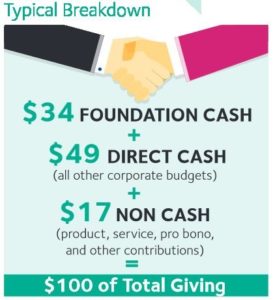Corporations are giving more than ever! According to Giving in Numbers, an annual survey produced by the Committee Encouraging Corporate Philanthropy (CECP), corporate philanthropy has stabilized over the last few years, indicating that it has become one of the hallmarks of corporate growth and success.
Of the 271 companies surveyed, all of which tout multi-billion dollar global revenue streams, $18.5 million was the median amount donated last year, with the top 25% giving just under $50 million.

Not surprisingly, almost 17% of all corporate philanthropy came from in-kind donations of various goods and pro bono services. It’s not surprising because corporations have a lot of ways to help at their disposal, including free consulting, employee volunteer campaigns, or gifted goods and products. But which is better?
The advantage for the non-profit from in-kind support is cost-savings, as opposed to funds raised, and a direct solution to a practical problem. The benefit to the corporation is the ability to work with their community partners in a dynamic way without spending additional capital.
At a recent conference, a director of fundraising at a prominent international non-profit gave mixed reviews of in-kind donation explaining that, “in-kind donations just aren’t as flexible as money. If they solve your particular problem at a particular time, it’s great, but that’s not always the case.”
His point is well made. There are elements of timing, coordination and fit needed for these donations, certainly more so than traditional investments. Indeed, cash would allow more flexibility; but in-kind donations are not typically alternatives to cash but rather additions to the cash donations.
In other words, they’re an extra bonus for non-profits — a 17% bonus in goods and services that may otherwise be unavailable to these organizations.
 What’s more, in-kind and pro bono donations also satisfy corporate objectives in a different way, making them a unique and sustainable win-win. For instance, the donation of a new software suite to a school district or free consulting to a growing non-profit can drive market or employee engagement in a way that cash sponsorship might not. While we’d like to consider philanthropy to be outside of the ROI-driven corporate agenda, it seems realistic to tie it to some conventional aspect of business, or even more than one at a time.
What’s more, in-kind and pro bono donations also satisfy corporate objectives in a different way, making them a unique and sustainable win-win. For instance, the donation of a new software suite to a school district or free consulting to a growing non-profit can drive market or employee engagement in a way that cash sponsorship might not. While we’d like to consider philanthropy to be outside of the ROI-driven corporate agenda, it seems realistic to tie it to some conventional aspect of business, or even more than one at a time.
Adobe, for example, donated a lab of computers (ready-made with their new software) to the Baltimore Design School back in 2013, along with a grant to further support the school. As part of the initiative, the company also incorporated a training program for the teachers at Baltimore Design School to educate them on how to incorporate student-driven media into their lessons. Also, thanks to their employee volunteer program, the company was able to provide some of their employees with time out of the office to help the school with their new equipment. Not only did the company provide the school with new tech, but they also helped create a more enriching experience for both the students and teachers.
The software company built brand rapport and engaged its employees at the same time by gifting more than just cash. All while creating an amazing story (and we all know why stories matter in business).
The travel industry, too, is reaching outside of the typical philanthropy box. Airlines, cruises, resorts and hotels are all developing unique programs to connect travelers with local charities in the countries they visit. Whether travelers are giving driving instructions to local women in Delhi, installing pipes to remove exhaust smoke from homes in Tanzania or volunteering their time at local camps or schools in Turks & Caicos, people on vacation are finding ways to contribute to the communities they are visiting thanks to the corporations who made their vacation possible.
Companies in the travel industry are not only finding unique ways to connect their customers with worthy causes, but they are also addressing a desire from their customers – particularly millennials and families who travel with children – to be given opportunities to make significant contributions to the communities they visit. This unique, out-of-box thinking positions these companies as community investors, while bolstering their brand by providing their target with uniquely fulfilling experiences.
We see other examples of corporate in-kind support all the time at Green Standards. Corporations that work with us take what would be wasted products and turn them into practical gifts for local non-profits. Countless desks, chairs, computers, whiteboards and printers are being diverted from the landfill, and instead repurposed among non-profit organizations. Specialized schools, medical centers and many more non-profits have all benefited from these in-kind donations. And so too have the corporate donors. What may otherwise have been senseless waste has become an opportunity to share and engage, and improve their overall waste management plan.
Many of the organizations that receive these donations don’t have the dedicated funds to furnish their office spaces and are forced to sacrifice budget in other areas of their operations to get the items they need. Or worse, they continue with a poorly resourced or even unsafe work environment. It’s another win-win for businesses and the communities they work in.
Corporate philanthropy and corporate social responsibility may be on the rise, but there’s clearly more to it than who has the most capital. The more corporations can think outside of the box and complement conventional ways of giving with pro bono and in-kind donations, the more problems they can help solve. And the beauty is that it can happen without the additional expenditure. By integrating different ways of giving with other business objectives – whether it be community relations, employee engagement, marketing, or sustainability – business can find creative ways to give more.



